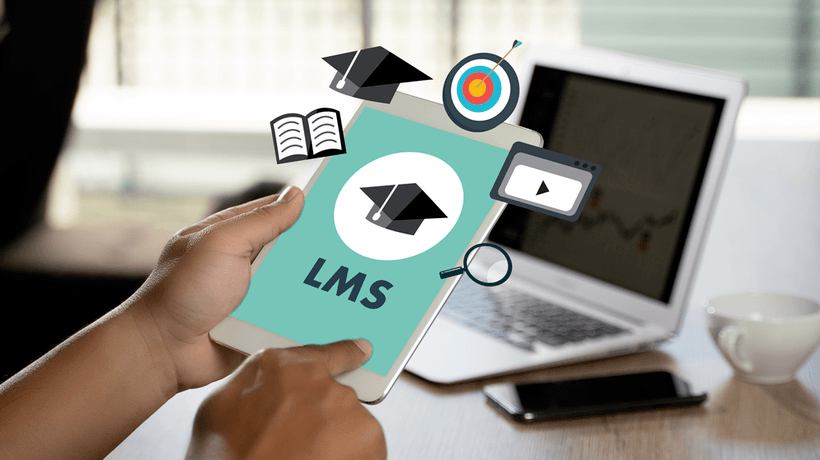Making Way For A Successful LMS Roll-Out
With time, the concept of education and learning has been transformed at a very consistent pace. More importantly, the increasing use of mobile devices and the internet has made learning more accessible than ever before. Thanks to the present-day learning management systems, learning now is not only restricted to schooling or college education but has enabled people from all age groups to foster training or skill development.
In case you are wondering how rapidly eLearning and online learning have grown, a report from Globe News Wire has found that the eLearning market is likely to soar by 374.3 Billion USD by 2026. Since the traditional LMS technology was only restricted to delivery and tracking, the modern-day solutions are designed to offer many more capabilities.
Though metrics related to course completions and operational costs could catch the attention of brands interested in creating an LMS, impact and engagement are two important factors that must be kept in mind, when needed, to ensure the most successful LMS launches. And if you are having a hard time understanding the concept of a successful LMS launch, let us quickly run through the essential tips that you must practice to have the desired outcomes of your learning initiatives.
5 Trends To Help You Align With The Future
Whether it's students, the workforce, or building essential skills, when it comes to taking over already existing LMS brands, it is only value and engagement that matter. Here are a few important trends that you must keep in mind when trying to aim for impactful releases:
1. Aim For Improved Access And Continuous Assessment
The pandemic has made most business organizations switch to remote working practices. However, the situation is likely to make businesses take a toll on engagement and learning. Thus, it is necessary that any kind of isolated feelings must be worked to roll out better assessment tools, and that too with improved access. Some of the few steps that could be taken to meet the goals include:
- Use of learner analytics tools to help students or employees have an assessment of their activities to know what's working for them.
- To consider learning journeys that have scope for bite-sized courses that can help with rapid learning, easy access, and immediate assessment.
- To ensure that an LMS should be accessible through mobile devices, allowing easy course deliveries.
2. Adopt Social Learning
Though online learning is associated with changing dynamics of learning, it is still necessary that social learning should be incorporated into the process. In other words, an LMS of the future should allow learners to connect well. A few steps that could help achieve social learning goals include:
- Making sure you set up some kind of discussion forums on various subjects to encourage interactive learning.
- Immersive virtual learning should be encouraged along with personalized training content.
3. Intelligent Content Generation And Use
Learning is all about creating content that is engaging. However, it is equally important that any content generated must avoid repetitive efforts. A few things that could help get the most of an intelligent content generation can be:
- Since technology is everything meant to prevent repetition, a successful LMS launch should accommodate the record features so that content can be shared or can be saved to improve the usefulness of resources.
- Restructure existing content or courses for microlearning to ensure learning could be done through module-based tests.
- Start redesigning all the existing or old online content to ensure no dull content reaches the learners.
4. Encourage Direct And Supportive Online Content
Another big struggle that your LMS may have to work on is to encourage the learners to stick with courses either directly or indirectly. This might even need you to reinforce the messaging from support admins to avoid any interruptions in the learning flow. Here's what you can do to align with such goals:
- Allow learners to flag any issues in the course content or share their feedback on content that works for them.
- Try incorporating artificial intelligence in your LMS to understand your learners' preferences, while chatbots could be used to plug any gaps or guiding the learners in the right direction.
5. Automation To Simplify Administration
Though it is always a good idea to have a team that keeps watching over the LMS, the administrative tasks meant to improve the user experience and better adaptability could be worked through automation tools. A few forms of using automation in an LMS include:
- Use of automation tools to share reminders, notifications, and emails adding to the learning curve.
- The data from analytics and AI can be leveraged to personalize course offerings for the learners. For instance, offering courses that could add more value to existing skills they have gained from a previous course.
- Automatic issuing of certifications or badges validating the learning journey of the user.
- Automation can even aid in designing a training process by pulling any critical user information that can help define learning goals for users.
All in all, the future of education, training, and interactions holds a huge scope for learning management systems. And when you need to launch a product that has the perfect social engagement with the right learning curve, it is necessary that all the tech updates, features, and content should be used in the strongest way possible.
Since we are done moving across the idea of generating maximum engagement with the LMS launch, it is time to explore how LMS testing could intensify your LMS launch for greater success.
Implementing LMS Testing For Progressive Launches
Even if your team has spent numerous hours deciding on the most popular industry trends that can be accommodated in the LMS, the inability to work on the technological aspect of the LMS could make you lose all the interest of the audience. Therefore, it is extremely necessary that you have a dedicated LMS testing team in place to work on the effective collaboration of hardware, software, and all the programming part of the product infrastructure. Moreover, having the right set of tactics and testing practices could help you improve your LMS launch for maximum success.
Start With The Code
To have your EdTech software tested for its functionality and performance begins with the code. Therefore, testing teams usually begin their hunt for app or software eating bugs with testing of the code. The practice focuses on working at unit testing so that small portions of the code can be tested for the desired outcomes. This will help you ensure that every portion of your LMS should work well as an individual unit before they are integrated. Moreover, it helps testers to aid developers with highly precise coding for effective outcomes on integration.
Compatibility Testing
Since targeting a bigger section of the market requires your LMS to be available on all popular platforms, operating systems, and devices, compatibility testing could help you yield greater service capabilities. Moreover, testing enables you to make your LMS application, as well as the website, run seamlessly across different browsers, either it is safari, chrome, or any other popular browser.
UX Or User Acceptance Testing
The next task that you need to take after completing the unit testing and successful integration of the LMS starts with user acceptance and UX testing. Since it is a crucial performance aspect, the testing process needs you to run highly specific test cases that can satisfy the end purpose and user requirements. However, the process needs you to have complete and precise documentation of your expectations for validating the existing development or any request for additional development.
Designing The Interface
Even if you manage to achieve the most compatible LMS that has some dynamic performance, another thing that you need to target is designing the interface. The process needs you to work on the intuitiveness of your software, with ease of loading courses, added retrievability of information, and rapid deliverability, as they are necessary to align with the usability testing goals. Besides, the ease of access and consistency of the information are few more things that you need to work on to provide a perfect navigational experience to your users.
Performance, Localization, And More
Once you are done working on UX, compatibility, interface, and anything that you need to have for your LMS project, the next big step that you need to take is to aim for performance testing. From running load tests to speed, response time, and resource usage, performance testing can help you create stable LMS systems. Moreover, you should necessarily check on localization so that an application that is meant to serve users across international boundaries tends to have a uniform experience.
8 Tips To Encourage Sustainable Engagement With Your LMS Roll-Out
Once you are done having all the trending and necessary tech updates into your LMS, the next big thing you need to foster is to meet the sustainability goals. Here are a few things that you can practice, to enjoy the best results:
1. Have A Perfect Roll-out Plan
When it comes to an ideal launch, it is vital that you have a perfect plan in place. This should start by defining the timeline of the launch followed by the schedule of everything and anything that must be worked before your LMS goes live. This stage may even involve extensive, yet defined meetings to work on administration and management plans related to the LMS.
2. Bring The Team Together
Developing the best learning management system needs you to have the right team at the right place. Moreover, when you are looking forward to launching a product that needs to serve a huge user base, consider having all the important people to give you a varied range of perspectives. This means having all the developers, programmers, testers, and project managers on the same page.
3. Familiarizing With An LMS
The next big step is something that you should start as early as possible. Even if you are the project owner or coordinator, it is vital that you must have a clear picture of the LMS, how it is likely to operate, and what is the USP of the system so that an impactful launch could be worked. This might even need you and your team to take on training on the features and functionalities so that the entire process of a launch could be worked to offer sustainable results, even when it is about questions you might have to tackle on the launch or through support services.
4. Know Your Audience
Whether you are creating an LMS for an organization or for some educational purposes, it is necessary that you must know your audience. It can be anybody who is a tech expert or a layman who has no idea of how an LMS works. Based on such information, you should consider designing the entire process to help varying audiences. Besides, a special check must be kept on the layout, tone, visuals, and all the explanatory things that can help improve the overall ambiance with the LMS.
This stage may require taking feedback from your teams, while EdTech testing services could be involved to understand an audience's needs and define test cases to satisfy the purpose. From hierarchy in the features to communication, it is important that your LMS must be crafted to meet your audience's goals.
5. Work On Integrations
When it comes to software or applications, users love to have a seamless experience. However, attaining such objectives needs you to have all the integrations sit perfectly so that stable and integrated communication can be established between servers, teachers, or users. Besides, integration testing done just right could help you create an LMS which is accessible and bring you all the tracking data you need for effective reporting and functionality.
6. Process Your Content
LMS is all about content, and therefore it is important that all the content you take to your audience must be processed well. Whether videos, audio, recordings, quizzes, or games, make sure all the content is made to deliver the perfect impression.
7. Run A Few Trials
Even when you believe you are done with all the checks necessary to offer the functionality and features, never hesitate to run a few trials. It can be a soft launch, where you could appoint a team of testers to find anything that has been overlooked. This will enable your team to work on experience, navigation, reporting, and communication while identifying any scope for improvements.
8. Never Overlook The Need For Communication
Finally, when you have a foolproof plan to work on the LMS launch, the most important thing that you need to work on is an informed launch. By informed, we mean to have all your team in sync so that any expectations related to an LMS must be fulfilled and there are no unexpected surprises.
Moreover, keeping the communication lines open even after the launch, makes it easier for your team to record feedback from real-world users. This will help you enjoy the opportunities to upgrade or improve anything that might challenge the user experience and navigation goals. Above all, having all your team in synchronicity before and after the launch gets you in a strong position to make the most of your LMS.
The Crux: Having The Best Of Trends, Testing, And Launch Tips
The concept of learning management systems and EdTech solutions is all about implementing extraordinary learning practices. Moreover, cultivating the interest of the learners' community could get difficult when you are struggling with the extensive competition. Thus, it becomes necessary that any organization working on the LMS should have the best of industry trends, quality testing services, and the right approach to launching a plan.
Whether it is incorporating AI, ML, crafting supportive learning, or practicing all the engagement activities making your way to sustainability, effective testing practices are the most important component of the LMS development that helps you yield success. And if you are planning to scale your learning operations to the widest range of audiences, pairing it all could help you have the most intensified and successful LMS launch.









